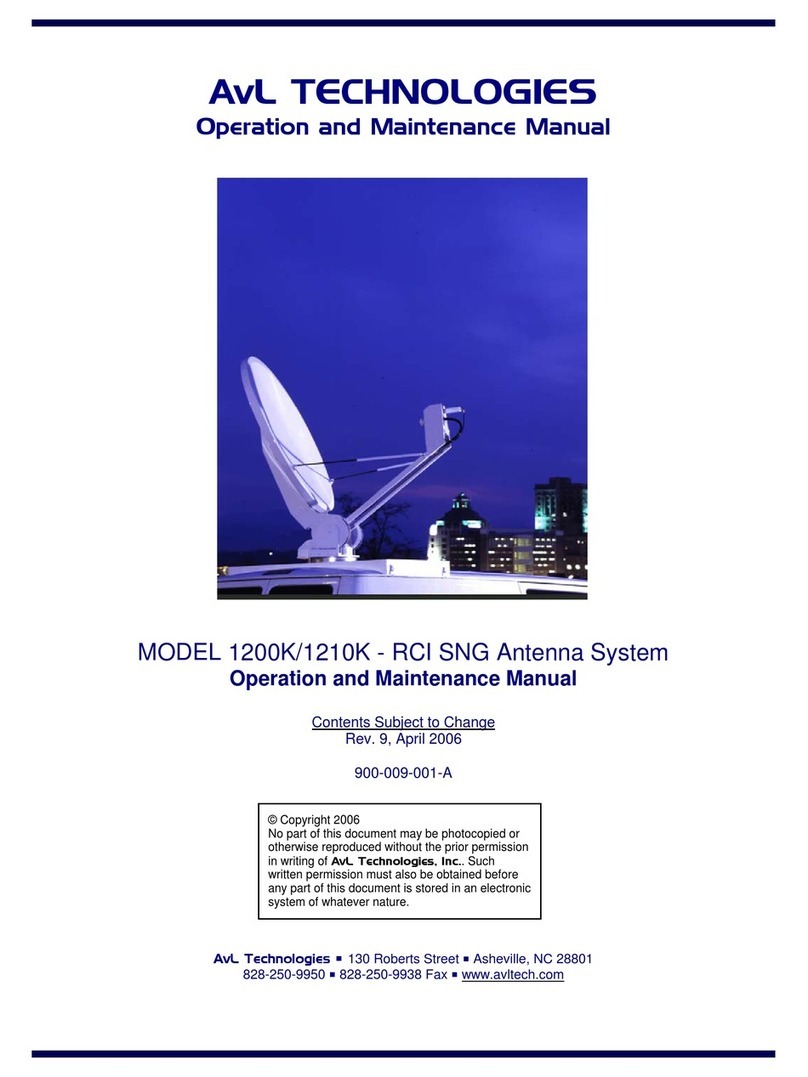
Model 1278K Mobile VSAT Antenna System 3 Operation and Maintenance Manual
SECTION 1 — OVERVIEW
TECHNICAL DESCRIPTION
The Model 1278K Mobile VSAT Antenna System is a three axis positioner featuring the simple,
rugged AvL cable drive system which produces very low backlash, high-stiffness and high-reliability
when driven by a low backlash, gear box with DC motors. All drive components are high-strength
steel, housed in lubricated-for-life housings, which results in the most reliable, no maintenance, stiff
system with the minimum of weight. The polarization drive rotates the feed assembly +/95° with
lightweight gear motor. A 20 lb. (9kg) HPA may be located on the feed boom.
AvL CABLE DRIVE SYSTEM
The patented AvL cable drive sytem utilizes highly reliable aircraft control cables in a redundant
configuration to achieve a zero backlash, light-weight, very stiff drive system. It achieves this high-
tech performance using low-tech components by wrapping the cable around the drive capstan
several times before wrapping the larger drive drum. The method used to wrap the capstan results in
a minimum free length of cable. The load in the cable on the main drum is exponentially reduced as it
is wrapped around the drum. Therefore, the total elongation of the cable when under load is
minimized. The AvL Cable Drive system results in stiffness of up to 10 times that of comparable gear
or
harmonic drive systems. The cables are pretensioned and spring loaded at the main drum
attachment point which eliminates backlash at installation and from any cable stretch in the future.
SECONDARY DRIVE SYSTEM
The Az and El AvL cable drive systems are driven by a low backlash worm gear set with a 40:1 ratio.
The factory low backlash of the worm gear set is reduced further by the AvL cable drive ratio resulting
in a lash of only .06 dB seen by the RF system. The gear sets are housed in a sealed housing which
allows the gear set to be continuously lubricated in synthetic oil which maximizes gear efficiency and
minimizes wear.
MOTOR DRIVES
Lightweight, reliable, DC motors with integral gearbox are used for the az, el and pol drives. These
motors were selected because they provide the best torque-to-weight ratio as well as allowing dual
speed operation for slewing and peaking. These motors produce constant torque over the speed
range with no cogging at low speeds, which ensures smooth operation when peaking antenna. The
24V DC design provides current limiting torque control and will allow vehicle battery operation if
necessary.
RF WAVEGUIDE
The positioner is designed so that the up-link BUC can be installed on the feed boom.
CONTROLLER
The TracStar Systems controller is manufactured by TracStar Systems, Inc. an antenna and controller
manufacturer. Complete operating instructions can be found in the TracStar Controller Operating
Instructions included on the accompanying disk.
CONSTRUCTION
Except for the drive components and bearings, all metal components are aluminum or stainless-steel.




























